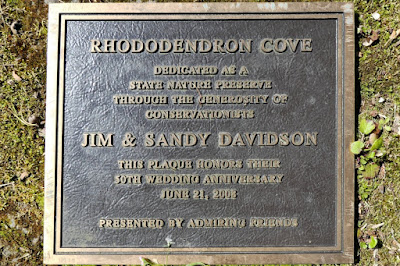These features were created from sandstone laid down hundreds of millions of years ago, when Ohio was beneath the ocean. After uplift and becoming dry land the sandstone began eroding, and finally collars of moraine debris were laid down at the base of high points during the last glaciation, which, this far south, didn't reach the tops of the "knobs."
Rhododendron Cove
Parking for Rhododendron Cove is across a side road from a natural gas compression station. After a short, flat walk the trail turns left and begins to climb.
The property was donated to ODNR, the Ohio Department of Natural Resources.
Ferns were poking up out of the ground, most still coiled and curled.
As were spring wildflowers, including the early saxifrage -- that's its name, early saxifrage.
The large-flowered bellwort. It's so bashful it never raises its head.
 |
| Note the perfoliate leaves -- the stem pokes through them. |
Climbing up to a switchback.
Heading through a slot in the sandstone.
The trail turns sharply right after the rocks above. For a short stretch it's quite steep.
The sandstone layers are often pocked with erosion features.
The cap blocks may be isolated from their neighbors.
The rhododendron weren't in bloom yet. They usually blossom between early and late June, depending on the weather.
Here they love sheltered, cool mini-canyons.
Erosion can also produce a lace effect.
Tons of violets were on the trails, purple, yellow, even white.
We even saw jack-in-the-pulpit.
Shallenberger
A short distance back towards Columbus from Rhododendron is the Shallenberger State Nature Preserve, another gift to ODNR. These pictures were taken on both 4/20 and 4/27.
The trail at Shallenberger isn't as demanding as at Rhododendron, but there is up and down. Joan and I soon encountered a hillside covered in large trillium.
A closeup. Notice the yellow pollen stains on the lower petals. (Click on the image to enlarge.)
A fallen trunk with a burl near its base.
We had plucked the occasional garlic mustard, an invasive species, back at Rhododendron, but Shallenberger needed lots of help. Some visitors had already been at work, with mustard corpses in the trail or hanging from trees. We walked down the paths slowly, sometimes diverting for five or ten minutes to pull up an egregious patch.
The hillsides were greening up nicely.
A red-bellied woodpecker, photo taken after a hasty rendezvous to generate more red-bellies.
The trail consists of two loops, one around each of a pair of knobs, joined by a short segment. The top of the first knob is accessible, if you're OK with stairs.
The view from the top will close in soon, as the leaves bust out, but I took this photo through one gap in the foliage. It's clear why the early settlers called these features "knobs."
A major shelf fungus.
Soon it was time to speed up our garlic mustard plucking and then return to the car. We had encountered only a few people on the trail during these two days of sunshine in the time of social distancing. Given the weather forecast, Joan and I should have another chance next week.


























No comments:
Post a Comment
Comments may not appear immediately as they are moderated by the author to eliminate spam. Please, no commercial links!